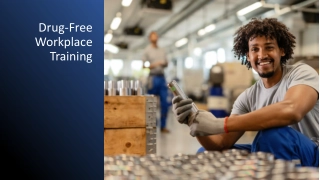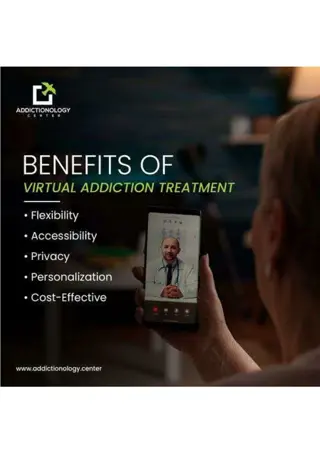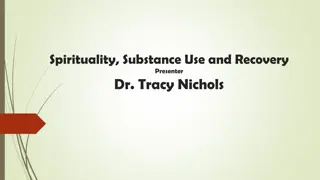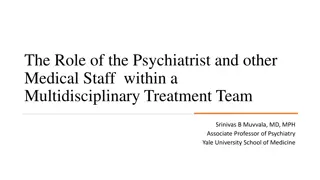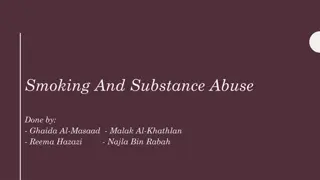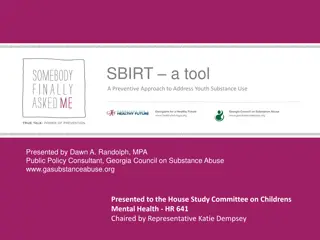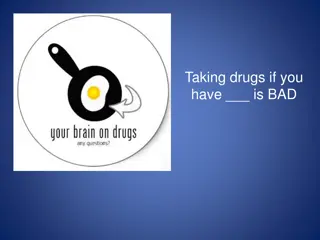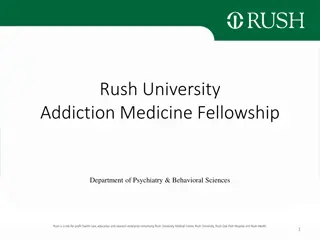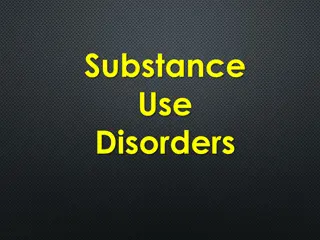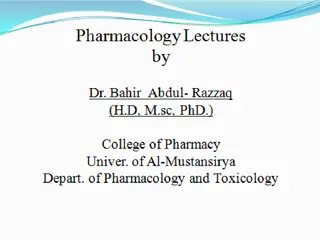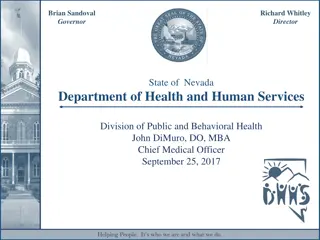Understanding Substance Abuse and Addiction in the Workplace
Substance abuse and addiction among employees can have detrimental effects on themselves and their colleagues. This program highlights the impact of alcohol and drug abuse, provides resources for referrals and treatment options, and explains the addictive process. By raising awareness and offering support, organizations can address this issue effectively.
Download Presentation

Please find below an Image/Link to download the presentation.
The content on the website is provided AS IS for your information and personal use only. It may not be sold, licensed, or shared on other websites without obtaining consent from the author. Download presentation by click this link. If you encounter any issues during the download, it is possible that the publisher has removed the file from their server.
E N D
Presentation Transcript
Substance Abuse Awareness Program for Supervisors Employee Assistance Program
Agenda 1. Substance Abuse Impact of employee alcohol/drug abuse Definitions Process of Addiction 2. Referring an Impaired Employee Bedoukian Policy Steps for FFD Referrals 3. Resources Employee Assistance Program Treatment Options and Resources Questions/Summary
Substance use disorders are common Ages 18-64, Annual Averages 2008-12 SAMHSA, NSDUH Report, 2014
Employees who abuse drugs and alcohol... Are about 3.5 times more likely to injure themselves or a co-worker Are 2.5 times more likely to have absences of eight days or more Are 5 times more likely to be involved in an accident off the job Work at about 65% of potential Make twice as many mistakes
Drug and Alcohol Abuse A Drug is a chemical substance that produces physical, mental, emotional or behavioral changes in the user. Drug Misuse is the use of a drug that varies from a socially or medically accepted use. Drug Abuse is any use of a drug that causes physical, psychological, economic, legal or social harm to the user or to others affected by the user s behavior.
Addiction A disease characterized by continued use and abuse of alcohol and/or drugs despite recurring negative consequences Both physical and psychological dependence often exist Loss of control over how much, how often person uses Primary, progressive, chronic, fatal (if left untreated)
The Addictive Process 1. Learning Mood Swing 2. Seeking Mood Swing 3. Harmful Dependency 4. Drinking/Drugging to feel normal/relieve pain _______________________________________ Pain Normal Euphoria Use of psychological defenses to protect habit
Why do some people develop addiction? Stress Genetic Predisposition Trauma Personal Psychology Sociocultural Influences Addictive Disease Drug Exposure Substance Use & Recovery, Seddon R. Savage MD, MS
When does substance use become a disorder? Loss of Control over Drug Use Use larger amounts or longer period of time than intended Persistent desire or unsuccessful efforts to cut down or control Great deal of time spent to obtain, use, or recover from effects Craving, or a strong desire to use
When does substance use become a disorder? Continue Use despite Harm Failure to fulfill major role obligations at work, school or home Persistent or recurrent social or interpersonal problems Important social, work or recreational activities given up or reduced Recurrent use in physically hazardous situations Persistent or recurrent physical or psychological problems due to use *Physiologic Impact Tolerance (increased amounts or diminished effects) *Withdrawal (withdrawal symptoms or use to avoid) *Criteria not met if taking solely under medical supervision Mild 2-3 Moderate 4-5 Severe 6+
Possible Warning Signs at Work Absenteeism (patterns?) Late for work Financial difficulties Frequent accidents Confused thinking Mood swings Legal problems Poor judgment Difficulty concentrating Problems with coworkers/supervisor Deteriorating personal appearance Emotional outbursts On-the-job absenteeism Forgetfulness
Things to Consider Substance Abuse represents only one example of personal problems that can affect job performance Similar signs may also come from other types of personal issues such as medical issues, financial problems, emotional or relationship problems However, substance abuse problems can present specific challenges for Supervisors when they lead to suspected impairment on the job
Drug Free Workplace Act (1988) Drug-Free Workplace Act (1988) Federal Law which requires employers who have federal contracts or who receive federal funds to maintain a drug free workplace Many states passed similar legislation Employers must have their own internal policies in place
Signs of Possible Impairment Coordination problems Unsteady gait Odor suggesting use of alcohol or other drugs Slurred speech Glassy or bloodshot eyes Confusion Drowsiness/Sleeping Erratic or bizarre behavior
Reasonable Suspicion Drug Testing Standard screenings test for: Alcohol (by breathalyzer) Marijuana Cocaine Amphetamines Opiates PCP
How long does it stay in your system? Amphetamines Cocaine Marijuana Opiates PCP Alcohol 1-2 days 2-3 days 7 30 days 2 days 2 days 1 day Times are approximate and may vary 16
For Reasonable Suspicion testing, you must observe at least one of the following: 1. Appearance (unkempt appearance, dilated pupils, red eyes, unsteady gait, drowsiness/sleeping on the job) 2. Behavior (hyperactive, aggressive, etc.) 3. Speech (slurred, incoherent) 4. Body Odor (odor of alcohol or marijuana) 17
Observations must be: SPECIFIC CONTEMPORANEOUS: the behavior, conduct, appearance, or body odor exists at the time the supervisor is making the observation ARTICULABLE: The observations can be documented; grounded in objective criteria 18
Steps for referring an employee under reasonable suspicion of impairment Observe and carefully document physical and mental signs and behaviors. Be objective, factual and specific. Involve another supervisor or other witness (HR) to confirm and document your reasonable suspicion of impairment. Remove employee from the work assignment. If it appears to be a medical crisis, call 911. If it does not appear to be a medical emergency, describe your observations to the employee and explain your responsibility to ensure a safe workplace.
Steps for Referring Employee (cont) Direct the employee to be immediately evaluated for impairment on the job. The evaluation should include a brief medical exam, alcohol and/or drug screening. Arrange transportation. Upon receiving medical report, take appropriate action based on the results (discipline, formal EAP referral, last chance agreement, etc.) Treat the incident confidentially. Information should only be given on a need-to-know basis.
Becomes defensive Cries What should you do if the employee Is silent and unresponsive Becomes hostile and belligerent Says he/she is sick and wants to go home Exhibits bizarre behavior and appears out of control Refuses to agree to evaluation Tries to leave with intent to drive
Any behavior which allows an employee to avoid experiencing the full consequences of his/her behavior Examples at work: Transferring the employee to another department Covering up for poor performance Failing to administer discipline when needed Attempting to help the employee by being a friend Overlooking tardiness and absenteeism Accepting excuses for poor performance Enabling
Confidential Free Voluntary Available to family members Offers convenient appointments Easily accessible Locations across the state Employee Assistance Program
EAP Components Assessment Brief Counseling Referral Follow-up Supervisory Consultation Crisis Intervention Trauma Debriefings Training
Treatment Options Detox Inpatient/Residential Intensive Outpatient (day/evening) Outpatient Medication Assisted Treatment (MAT) Self-Help Groups (AA, NA, Smart Recovery) Sober Living
Medication Assisted Treatment FDA has approved several different medications to treat opioid addiction and alcohol dependence. Medications work by reducing craving or blocking euphoric effect of opioid Buprenorphine, partial opioid Methadone, full opioid Naltrexone, opioid blocker Options for alcohol Naltrexone Acamprosate Disulfiram Medications should be used in conjunction with psychosocial therapies
How Can You Help? Learn the facts about substance abuse Refer early and at every step of the warning process Refer based on observable signs and symptoms Do not attempt to diagnose the problem If impairment is suspected, focus on your responsibility for ensuring a safe workplace Don t enable the problem to continue (ignoring behavior, covering up, transferring employee, avoiding discipline, etc.) Get help for yourself if needed (EAP, Al-Anon)
Resources Websites nida.nih.gov (National Institute on Drug Abuse) niaaa.nih.gov (National Institute on Alcohol Abuse and Alcoholism) dmhas.state.ct.us (Connecticut Department of Mental Health and Addiction Services) findtreatment.samhsa.gov(provides list of all treatment facilities by state)
Resources Connecticut Clearinghouse (ctclearinghouse.org) Alcoholics Anonymous (ct-aa.org) Narcotics Anonymous (ctna.org) Cocaine Anonymous (caofct.org) Al-Anon (ct-al-anon.org) Call UConn EAP at any time for consultation 860-679-2877 or 800-852-4392



